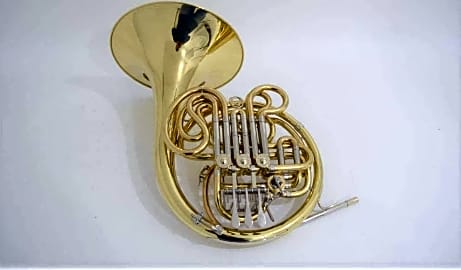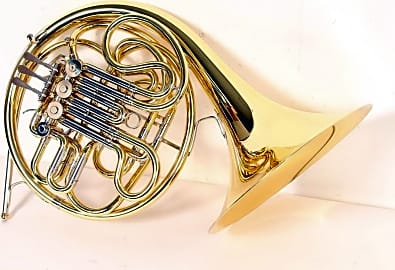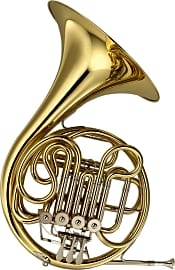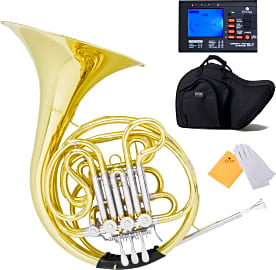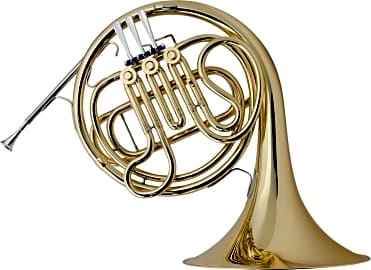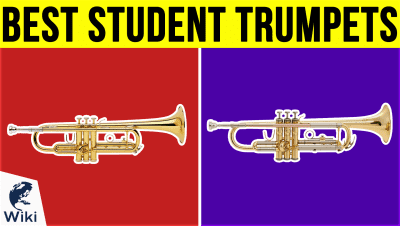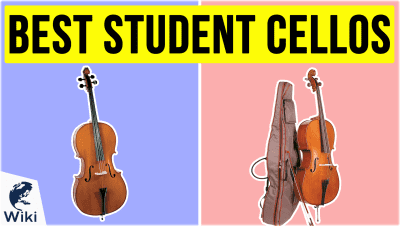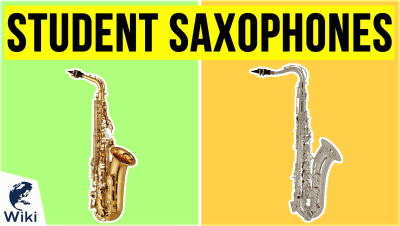The 6 Best Student French Horns

This wiki has been updated 36 times since it was first published in October of 2016. Thinking of taking up the French horn or know someone in your family who is? While it is among the most taxing instruments to master, it can also produce some of the most sublime sounds. These student models are good enough to learn on without breaking the bank, and some of them are of high enough quality to last well into a collegiate or even semi-professional career. When users buy our independently chosen editorial picks, we may earn commissions to help fund the Wiki.
Editor's Notes
May 08, 2020:
We're not going to lie: buying a french horn, especially for a beginner, can be a particularly daunting task. One reason for this is their remarkably high cost when compared to other brass instruments and wind instruments in general. You might notice on various e-commerce sites that there are actually some horns available for relatively low prices, but it's important to understand the issues that such low-cost models have. The Mendini MFH-30, for example, looks every bit as nice as many more reputable models, but the quality control and manufacturing standards are so inconsistent that you're basically playing the french horn lottery. If you get one that's made well, it might last a year or slightly more until you're ready to invest considerably more, but it's also entirely possible that you'll get something that's barely playable. Nonetheless, because the Mendini is so much less expensive than most others, it's worth being aware of.
Another aspect is single vs. double horns. Double horns are, far and away, the most common, and while they are a bit more complex, it's generally recommended that beginners skip over single models and go straight to the doubles. In that light, if you are considering a single, don't spend more than a few hundred on it, because it almost definitely won't be sufficient once you start to improve and move on to more complicated music with more talented accompaniment and more demanding directors. That said, if you just want to test the waters of the horn, the Conn 14D is a high-quality single model that offers a quality introduction.
The Geyer-style Yamaha YHR567 is notably more expensive than most people would spend on a beginner instrument, but it's suitable for intermediate and some professional uses as well as for students, and it's still not as costly as a truly high-end model. The Conn 6D Artist Series and Holton H379 are both extremely popular options that promise to serve nearly any player well, and they're less expensive than the Yamaha by a significant amount. Meanwhile, the Blessing BFH-1460 offers an impressive compromise between performance and price.
Special Honors
Dillon Music Here you'll find a wealth of models for sale, both from big-name manufacturers and commissioned and branded by Dillon themselves. The house-branded options are considerably less expensive than most and the more popular brands are guaranteed to be either brand new or very well serviced. dillonmusic.com
Mack FH600L While many imported models are of questionable manufacturing quality, Mack does a great job of vetting their suppliers and offering highly playable and durable instruments, which allows them to sell good-sounding horns at roughly half the price of even used models from more popular brands. mackbrass.com
Houghton Horns Karen and Dennis Houghton are among the most well-known horn instructors and importers around, and their shop offers both new and used models that are certain to be of high quality and in good repair. Even if you can't get to them in person, their online presence is frequently lauded for its comprehensive service. houghtonhorns.com
The Benefits Of Music Education
It takes hours of practice and dedication, and lack of natural ability may be a significant limiting factor.
Raising kids is among the most challenging tasks a human being can undertake, and it only seems to get harder and more complicated with each passing year and each new technological development. The fear, particularly in regards to that latter issue, is that all this uninhibited screen time might be doing irreparable damage to our children on a cognitive, psychological, and emotional level.
Unfortunately, there isn’t a lot you can do to halt the march of innovation, but you can include certain tried and true activities and lessons in your child’s life that may forestall his or her complete neurological atrophy. One of those is music education.
Learning an instrument has long been regarded as a reliable way to build new pathways in the brain, to strengthen character, and to give individuals both a sense of accomplishment and a way into a community of fellow musicians.
A litany of recent research papers reinforces the mental benefits of learning an instrument. In the last few decades, more and more research has been done into the so-called plasticity of the brain, its inherent ability to rewire itself as needed. Essentially, that means old dogs really can learn new tricks — and reap the cognitive benefits of the process. Musicians as a whole demonstrate increased alertness and focus, as well as higher scores on a variety of tests, from basic IQ tests to complex math exams. The reasons for this are varied and only partially understood, but the evidence is clear.
For young students, particularly those in grades K-12, learning an instrument is an all but guaranteed way to introduce them to a community. Whether your child is already plenty popular or they have a hard time making friends, the bonds he or she forms with fellow players will be nearly unbreakable. It also doesn’t hurt to get them involved in this kind of extracurricular activity early, as a commitment to something like that looks great on a college application.
Musicians have to fail a lot to get good. They have to hit the wrong notes, sometimes even in a very public setting, to improve. It takes hours of practice and dedication, and lack of natural ability may be a significant limiting factor. But your kid can do it. And when they do, they’ll come out the other end much stronger for having done it, and they’ll be able to tackle pretty much anything life throws at them with the same grit and panache.
Why The French Horn? And Which One?
There are a lot of instruments to choose from out there. Most young musicians will reach for something they see others play. That means guitars, basses, drums, and keys are toward the top of the list, though piano lessons seem to have the same stigma among very young children as a heaping helping of Brussels sprouts.
If you’re lucky enough to get them interested in a more classical instrument, they’re liable to gravitate toward something like the violin, cello, trumpet, or a similar instrument with a lot of crossover potential. Why would a budding musician reach for the French horn?
It may be because they love movies. The French horn has proved integral to the soundtracks of an enormous number of blockbusters, from Jurassic Park to Star Wars. Picking up a French horn and getting good at it might just be a quick way into the movie business.
Many student kits come with cases, cleaning supplies, tuners, and more, much of which can save you a lot of time and money buying elsewhere.
Once you’ve decided that the French horn is for you (or your kid), you still have to figure out which one to buy. The vast majority of French horns for students are rather similar in design and performance, with the primary differences coming in terms of bore size, valve quality, key, and finish.
To the point of bore size, larger bores will usually produce a better sound, but that makes for a larger, heavier instrument that might overwhelm particularly young or small players. Valve quality is perhaps more important, as a good set of valves will make the instrument much more playable. Valves will come either mechanically linked, or linked to their rotors by strings. Mechanical links are ideal for students, as they’re significantly more durable, even if they have a tendency to stick. String links are superior in performance and are noticeably quieter — an important characteristic during a recital — but they can break and will need to be replaced.
You'll also notice two types, single and double horns. Single horns have three valves in total, while double horns have an additional key that brings a much longer tube into the mix and opens up a considerably larger range of notes while allowing you to play the notes already in your repertoire with better intonation. If you're absolutely set on saving money, a single might be worthy of consideration, but don't ever spend too much on one. The vast majority of players will be best served by a double horn.
Keep an eye out for extra tools, as well. Many student kits come with cases, cleaning supplies, tuners, and more, much of which can save you a lot of time and money buying elsewhere.
A Brief History Of The French Horn
French horns, like all horns, have roots in the actual horns of animals that prehistoric man would blow on to create sound. These were obviously much more rudimentary than horns played today, but they laid the groundwork both in design and performance. A lot has changed since then, however, and instruments like the French horn have become wildly complex by comparison.
The German variant incorporated devices called crooks that could change the key of a single instrument.
The term French horn actually derives from the need to separately designate the hunting horns used in France from those used in Germany, the latter of which actually had more tonal flexibility, as the original French hunting horns of the 17th century were more like bugles in that they could only be played in a single key. The German variant incorporated devices called crooks that could change the key of a single instrument.
Eventually, into the 18th century, those very same Germans would add valves to the horn, and French manufacturers did the same, creating a horn that belongs in many ways to both nations. It’s mostly in America that this particular instrument garners the name French horn, while overseas it is often only referred to as an orchestral horn.
Nowadays, well-known manufacturers like Yamaha, Holton, and Conn dominate the world of high-quality french horns, although there's an increasing number of low-cost imported knock-offs. These bargain-basement, often unheard-of brands generally offer one thing: affordability, and not much else. Due to the nature of horns, they're difficult and expensive to manufacture, and if you try to get by with an ultra-cheap, imported option, you might make out with something playable, but it's just as likely that you'll waste your time and money and get the runaround from an overseas manufacturer if you try to return it.


